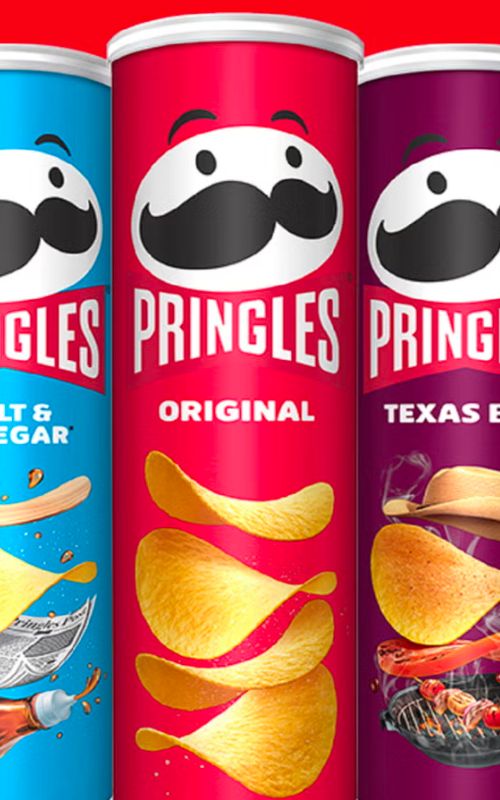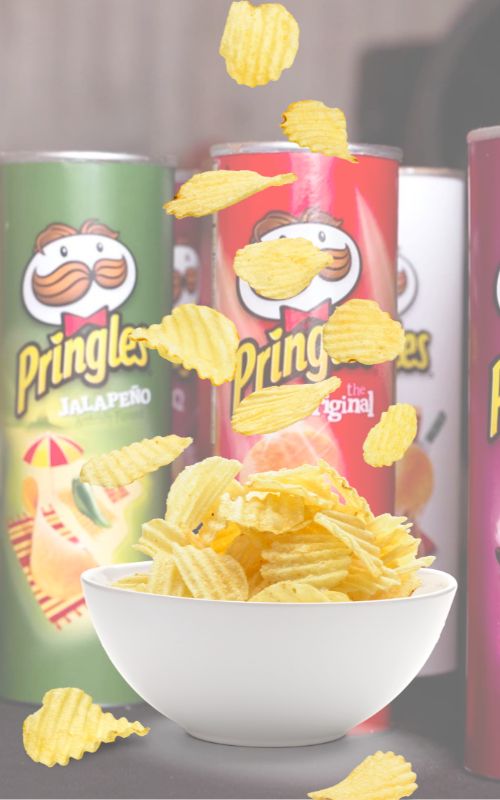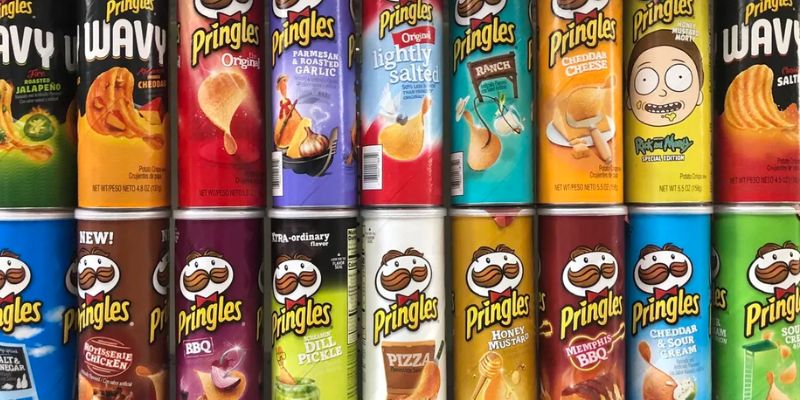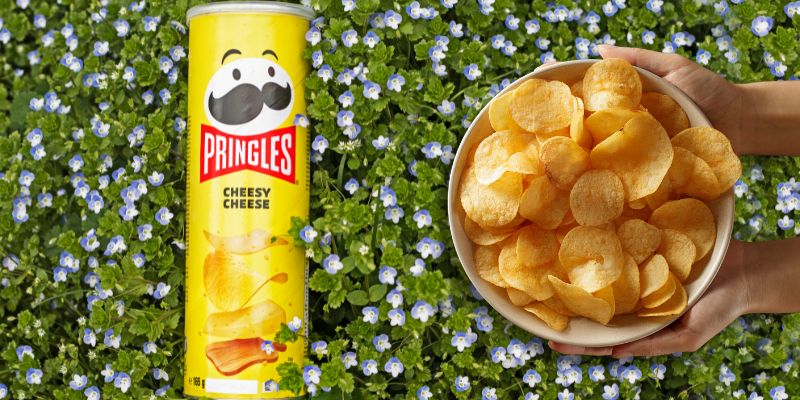No, Pringles aren’t really a potato chip. They are made from potatoes but they don’t meet all the criteria to be classified as a potato chip.
When it comes to snacking, Pringles is one popular item that has captured the hearts and taste buds of many.
Known for their unique shape, stackable design, and variety of flavors, Pringles have been a staple snack for decades. But despite their apparent similarities to potato chips, there has been an ongoing debate on whether or not Pringles can truly be classified as potato chips.
The key to understanding this debate lies in closely examining the ingredients found in these popular crisps. Potato chips are typically made from thinly sliced, oil-fried, and seasoned potatoes.
Conversely, Pringles are made from a mixture of dried potatoes, cornstarch, vegetable oil, and other ingredients. This unique composition has led to questions surrounding their classification as a potato chip.
Key Takeaways
What Are Pringles?
Pringles are a popular snack food known for their unique shape and packaging. They are created from a mixture of dried potatoes, wheat starch, corn flour, and rice flour, combined with vegetable oil and maltodextrin to create a dough-like consistency.
This mixture is then rolled out, shaped into the iconic hyperbolic paraboloid form, and seasoned with various flavors.
Unlike traditional potato chips, Pringles are not made from slices of potatoes. Instead, they utilize dehydrated processed potatoes and a blend of other grains like corn, rice, and wheat.
This combination of ingredients allows for a more uniform shape and consistent texture, making Pringles a fun and easily stackable snack option.

The unique shape of Pringles is not just for aesthetics. The hyperbolic paraboloid is engineered to maximize crunchiness while maintaining the structural integrity of the chip. This means that Pringles can be enjoyed without the worry of breakage and offer a satisfying crunch with every bite.
In addition to their distinctive composition, Pringles are available in various flavors. From classic options like Original and Sour Cream & Onion to more adventurous offerings, a Pringles flavor suits everyone’s taste preferences. Each flavor is carefully crafted to complement the base ingredients and provide a delicious snacking experience.
In conclusion, Pringles are a distinct snack option offering unique ingredients, form, and flavors.
Their innovative design and enjoyable taste make them popular for those seeking a fun and tasty treat.
A Closer Look at the Ingredients
When it comes to Pringles, their ingredients set them apart from traditional potato chips. Pringles are made using a combination of corn, potato flakes, rice, and wheat, starting with a slurry that is later shaped and fried. This recipe makes them different from regular potato chips, which are simply slices of potato fried in oil.
The key ingredients in Pringles include dried potatoes, vegetable oils (such as corn, cottonseed, high oleic soybean, and/or sunflower oil), degerminated yellow corn flour, cornstarch, and rice flour.
Along with these base ingredients, Pringles also contain maltodextrin, mono- and diglycerides, and salt. Wheat starch is another ingredient in Pringles, which contributes to their unique texture and taste. Mono- and diglycerides are considered emulsifiers, which help to maintain the product’s structure and consistency.
Regarding nutrition, Pringles tend to be lower in sodium and fat content compared to traditional potato chips. However, they still contain some sodium levels, primarily sourced from the added salt. The exact amount of sodium and fat in Pringles can vary depending on the flavor and any additional seasonings used. Saturated fat is typically present in the vegetable oils used, but at a lower level than natural potato chips.
Though some Pringles might contain artificial flavoring, the brand is known for experimenting with unique flavors not typically found in potato chips, such as pizza and Reuben. To create these flavors, various seasoning blends are used, which can contribute to the overall nutritional content of the product.
In conclusion, Pringles’ ingredients create a distinct texture and taste compared to traditional potato chips. While they might not be made purely of potatoes, the combination of corn, rice, wheat, and other ingredients gives them their own unique appeal. Despite some differences in nutritional content, it’s important to remember that Pringles, like any potato chips or salty snacks, should be consumed in moderation as part of a balanced diet.
Are Pringles Potato Chips?
One brand often comes to mind when discussing potato chips: Pringles.
However, it may surprise some to learn that Pringles aren’t actually considered potato chips. Instead, they are classified as potato crisps. The distinction between potato chips and potato crisps lies in the way they are made and the ingredients used in their production.
Potato chips are traditionally made by slicing and frying whole potatoes, while Pringles are created using a different process. Pringles are made from a dough comprising of dehydrated processed potato, rice, wheat, and corn. This dough is then rolled out into a thin layer and cut into an oval shape, which gives Pringles their distinct appearance.

The unique composition of Pringles has sparked debates over their classification as potato chips. In fact, the U.S. Food and Drug Administration (FDA) ruled in 1975 that Pringles could only be called “chips” if they provided a disclaimer identifying them as “potato chips made from dried potatoes.” Instead, Pringles chose to label their product as potato “crisps.”
This decision was further supported by a court ruling which sided with Procter & Gamble’s argument that Pringles did not contain enough potato to have the quality of “potatoness” and did not resemble the shape of a traditional potato chip. Pringles were, therefore, deemed to be a savory snack rather than an actual potato chip.
In summary, Pringles’ unique dough-based composition and manufacturing process set them apart from traditional potato chips. As a result, they are more accurately described as potato crisps.
Pringles vs. Traditional Potato Chips
Pringles are a popular salty snack that differs from traditional potato chips in several respects. To begin with, Pringles are made from a mixture consisting of 42% potato content, with the remaining 58% made up of vegetable oil, rice flour, wheat starch, maltodextrin, salt, and dextrose, creating a unique composition. In contrast, conventional potato chips are made by slicing and deep-frying whole potatoes.
The texture of Pringles also sets them apart from traditional potato chips. Their signature parabola shape and uniformity contribute to a consistent crunch and mouthfeel. The process used to achieve this shape involves pressing a slurry of ingredients into a thin sheet, which is then mechanically cut into the iconic curved form. On the other hand, regular potato chips have a more varied texture due to the different thicknesses of the potato slices and their uneven frying.
Breakage is another key difference between Pringles and conventional chips. Pringles are specifically designed to be stackable, which minimizes breakage and ensures that consumers receive intact pieces. This is in stark contrast to traditional potato chips, where broken pieces are common and can sometimes lead to a less satisfying snacking experience.
Another notable aspect is the greasiness of the two snacks. Traditional potato chips are often perceived as greasier due to the deep-frying process. Pringles, with their unique production method, tend to be less greasy while still retaining a satisfying salty flavor. This can make them a more appealing option for those who prefer a less oily snack.
In summary, while Pringles share some similarities with traditional potato chips, such as their salty taste and overall texture, there are significant differences in their composition, shape, breakage rate, and greasiness. These distinctions set Pringles apart as a unique and well-loved snack option.
The Debate over Taxes
In the United Kingdom, a heated debate arose over whether Pringles should be classified as potato chips and therefore subjected to the Value Added Tax (VAT). The British government imposed a Value Added Tax on potato chips, which Procter & Gamble, the maker of Pringles, aimed to avoid by claiming that their product is not a conventional potato chip.
This argument led to a legal battle as Procter & Gamble and the government faced off in court. Lawyers for the multinational company argued that Pringles were not made from potato flour, but rather a mixture of ingredients, and therefore could not be considered as potato chips in the traditional sense. They also noted that the product’s shape, which is unique compared to other chips, was another factor that distinguished it as a separate entity.
The case reached the Court of Appeal, where the judges had to assess the composition and characteristics of Pringles to determine their classification. In a surprising decision, the British high court ultimately ruled that Pringles are indeed potato chips, making the VAT applicable to the product.
Throughout this debate, the question of Pringles’ identity as potato chips stirred confusion for both the legal system and the public. In the end, the conclusion reached by the United Kingdom’s high court set a legal precedent for how such products should be defined and taxed.
History and Brands
Pringles, an American brand of stackable potato-based chips, were invented by Procter & Gamble (P&G) in 1968 and marketed as “Pringle’s Newfangled Potato Chips.” The brand was sold in 2012 to Kellogg’s, and as of 2011, they were available in more than 140 countries.
The creation of Pringles can be attributed to chemist Alexander Liepa, who was employed by P&G. Initially, the chips’ name didn’t have any specific origin or meaning but eventually stuck. The unique recipe and manufacturing process were developed to address the issues of broken, greasy, and stale chips, which were common problems faced by traditional potato chips.
Pringles became famous for their light and crisp texture, along with their unique flavors not typically seen in the potato chips market. Some popular flavors include the Original Pringles, Pizza, and other innovative combinations well-known today.
Although Pringles were advertised as potato chips, they faced a challenge from the U.S. Food and Drug Administration in 1975 due to their reduced potato content. Pringles eventually opted for the term “potato crisps” on their packaging to comply with labeling regulations, distinguishing them from traditional potato chips.
In recent years, Pringles expanded its presence globally, thanks in part to Kellogg’s acquisition. The brand continues to evolve, launching new flavors and limited edition varieties, maintaining its position as an iconic snack choice across different cultures. One of the most famous slogans, “Once you pop, the fun don’t stop,” remains synonymous with Pringles, reflecting the ongoing popularity of this uniquely shaped and flavored snack.
Understanding the Packaging
Pringles are well known for their distinctive, parabola-shaped chips and cylindrical container. With their mathematically calculated hyperbolic paraboloid shape, the chips are designed to fit perfectly within the can. This efficient packaging allows the chips to be stacked, maximizing the number of chips per container while minimizing breakage.

The Pringles can consists of a cardboard body with an aluminum lining inside and a foil lid. The unique design helps maintain freshness of the chips and prevents them from being crushed during transport. However, this packaging has been criticized for having negative environmental impacts.
The can’s composition makes it difficult to recycle, leading to improvements in recent years to address these concerns.
Pringles, unlike traditional potato chips which are made from raw sliced potatoes, are formed from a mixture of dried potato granules, potato flour, and other ingredients (source). Due to their innovative design and distinctive packaging, Pringles have always been perceived as different from other traditional potato chip brands. There is some confusion in the market about whether Pringles should actually be considered potato chips.
In summary, Pringles’ packaging is unique and efficient, ensuring that the chips arrive in excellent condition to consumers. However, the environmental aspect has been a challenge that the company continues to address. The packaging and the chips’ composition contribute to their distinct identity in the market and raise the question of whether they should be classified as potato chips.
Frequently Asked Questions
Why are Pringles different from other chips?
Pringles have a unique shape, taste, and texture compared to traditional potato chips. This difference is due to their manufacturing process, which involves using potato dough made from ground dried potatoes rather than raw potato slices. This results in a lighter, less greasy snack that’s easier to eat.
What are the main ingredients in Pringles?
The primary ingredients in Pringles are dried potatoes, vegetable oils, and a blend of seasonings specific to each flavor. These ingredients are combined to form a dough, which is then shaped, fried, and seasoned to create the famous Pringle crisp.
Which company launched the Pringles brand?
Procter & Gamble originally introduced Pringles in 1967. The brand has since changed ownership multiple times, with Kellogg’s eventually purchasing Pringles in 2012.
How do the flavors of Pringles differ?
Pringles offers a variety of unique flavors not commonly found in traditional potato chips, such as pizza and Reuben. These flavors cater to those seeking a more adventurous snacking experience and set Pringles apart from other chips on the market.
Are Pringles baked or fried?
Pringles are fried during the manufacturing process. The potato dough is formed into its iconic shape and then fried to achieve the crisp texture that consumers enjoy.
Is there a gluten-free option for Pringles?
Currently, there is no gluten-free option for Pringles. The ingredients used in manufacturing may contain gluten, including the dried potatoes and various seasonings. Individuals with gluten sensitivities or allergies should exercise caution when consuming Pringles and check the ingredients list carefully.





Leave a Reply